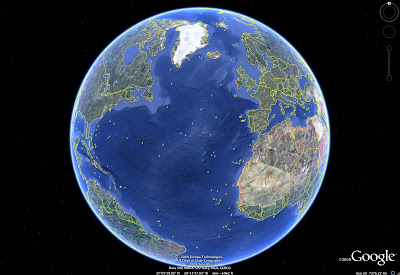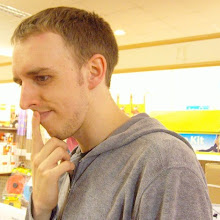In my current job I am producing a database of fossil occurrences from the North Atlantic deep sea record and one of the fields in the data base is latitude-longitude for each of the IODP holes included. For a while now I've been wanting to export this data to a KML file (Google Earth's HTML-like file format). At first I figured this would be easy. I created an SQL query in Access to get my data out as a comma-delimited file which I then import into R. All I need to do is create a table of unique lat-long occurrences (holes) and their names then format them in the KML-style. However, I came up against a bit of a snag.
The first part is easy. Just set the header of the file to:
<?xml version="1.0" encoding="UTF-8"?>
<kml xmlns="http://www.opengis.net/kml/2.2">
The footer to:
</kml>
Then each hole is entered as a Placemark using the following syntax:
<Placemark>
<name>Hole name</name>
<Point>
<coordinates>-122.0822035425683,37.42228990140251,0</coordinates>
</Point>
</Placemark>
Where the coordinates are longitude, latitude and altitude respectively.
Simple.
But once you import the whole file into Google Earth it only shows the first point (hole) and skips all the others. Google's own code site wasn't much use on this, and the few forum's I looked at seemed to be missing a proper answer to this problem. In the end I figured out that all that needs to be done is wrap the placemarks in a simple
<Document></Document>
tag.
Lesson learned, and shared.
(Image and original code below.)

<?xml version="1.0" encoding="UTF-8"?>
<kml xmlns="http://www.opengis.net/kml/2.2">
<Document>
<Placemark><name>110_671B</name><Point><coordinates>-58.73,15.52,-1622</coordinates></Point></Placemark>
<Placemark><name>110_672A</name><Point><coordinates>-58.6,15.5,-1581</coordinates></Point></Placemark>
<Placemark><name>110_673B</name><Point><coordinates>-58.64,15.53,-1875</coordinates></Point></Placemark>
<Placemark><name>110_674A</name><Point><coordinates>-58.9,15.5,-2003</coordinates></Point></Placemark>
<Placemark><name>110_676A</name><Point><coordinates>-58.7,15.53,-1494</coordinates></Point></Placemark>
<Placemark><name>149_897A</name><Point><coordinates>-12.47,40.83,-5320</coordinates></Point></Placemark>
<Placemark><name>149_899B</name><Point><coordinates>-12.26,40.77,-5291</coordinates></Point></Placemark>
<Placemark><name>149_900A</name><Point><coordinates>-11.6,40.68,-5037</coordinates></Point></Placemark>
<Placemark><name>149_901A</name><Point><coordinates>-11.05,40.67,-4719</coordinates></Point></Placemark>
<Placemark><name>152_914A</name><Point><coordinates>-39.72,63.46,-533</coordinates></Point></Placemark>
<Placemark><name>152_919A</name><Point><coordinates>-37.46,62.67,-2088</coordinates></Point></Placemark>
<Placemark><name>157_950A</name><Point><coordinates>-25.6,31.15,-5438</coordinates></Point></Placemark>
<Placemark><name>157_951A</name><Point><coordinates>-24.87,32.03,-5437</coordinates></Point></Placemark>
<Placemark><name>157_952A</name><Point><coordinates>-24.5,30.79,-5432</coordinates></Point></Placemark>
<Placemark><name>159_959A</name><Point><coordinates>-2.73,3.62,-2091</coordinates></Point></Placemark>
<Placemark><name>159_960A</name><Point><coordinates>-2.73,3.58,-2048</coordinates></Point></Placemark>
<Placemark><name>159_961A</name><Point><coordinates>-3.05,3.44,-3292</coordinates></Point></Placemark>
<Placemark><name>159_962B</name><Point><coordinates>-3.18,3.25,-4637</coordinates></Point></Placemark>
<Placemark><name>160_966F</name><Point><coordinates>32.7,33.79,-923</coordinates></Point></Placemark>
<Placemark><name>101_627B</name><Point><coordinates>-78.29,27.63,-1026</coordinates></Point></Placemark>
<Placemark><name>160_967E</name><Point><coordinates>32.72,34.06,-2553</coordinates></Point></Placemark>
<Placemark><name>160_969B</name><Point><coordinates>24.88,33.84,-2202</coordinates></Point></Placemark>
<Placemark><name>164_994C</name><Point><coordinates>-75.54,31.78,-2799</coordinates></Point></Placemark>
<Placemark><name>165_998A</name><Point><coordinates>-82.93,19.48,-3180</coordinates></Point></Placemark>
<Placemark><name>101_628A</name><Point><coordinates>-78.3,27.5,-964</coordinates></Point></Placemark>
<Placemark><name>105_646B</name><Point><coordinates>-48.36,58.2,-3106</coordinates></Point></Placemark>
<Placemark><name>101_635B</name><Point><coordinates>-77.3,25.4,-3081</coordinates></Point></Placemark>
<Placemark><name>103_637A</name><Point><coordinates>-12.9,42.1,-1243</coordinates></Point></Placemark>
<Placemark><name>101_626C</name><Point><coordinates>-79.54,25.6,-844</coordinates></Point></Placemark>
<Placemark><name>149_898A</name><Point><coordinates>-12.12,40.68,-5279</coordinates></Point></Placemark>
<Placemark><name>103_638B</name><Point><coordinates>-12.19,42.15,-1890</coordinates></Point></Placemark>
<Placemark><name>103_639A</name><Point><coordinates>-12.24,42.14,-1829</coordinates></Point></Placemark>
<Placemark><name>103_640A</name><Point><coordinates>-12.5,42,-1363</coordinates></Point></Placemark>
<Placemark><name>103_641A</name><Point><coordinates>-12.18,42.15,-1918</coordinates></Point></Placemark>
<Placemark><name>104_642B</name><Point><coordinates>2.92,67.22,-1283</coordinates></Point></Placemark>
<Placemark><name>104_643A</name><Point><coordinates>1,67.7,-2769</coordinates></Point></Placemark>
<Placemark><name>104_644A</name><Point><coordinates>4.57,66.67,-1215</coordinates></Point></Placemark>
<Placemark><name>107_651A</name><Point><coordinates>12.8,40.2,-2974</coordinates></Point></Placemark>
<Placemark><name>107_652A</name><Point><coordinates>12.1,40.4,-3094</coordinates></Point></Placemark>
<Placemark><name>107_653A</name><Point><coordinates>11.44,40.26,-2821</coordinates></Point></Placemark>
<Placemark><name>107_654A</name><Point><coordinates>10.7,40.6,-2209</coordinates></Point></Placemark>
<Placemark><name>107_655A</name><Point><coordinates>12.46,40.17,-3234</coordinates></Point></Placemark>
<Placemark><name>108_657A</name><Point><coordinates>-20.94,21.33,-2332</coordinates></Point></Placemark>
<Placemark><name>108_658A</name><Point><coordinates>-18.58,20.74,-2264</coordinates></Point></Placemark>
<Placemark><name>108_659B</name><Point><coordinates>-21.02,18.07,-3073</coordinates></Point></Placemark>
<Placemark><name>108_660A</name><Point><coordinates>-19.24,10.01,-2221</coordinates></Point></Placemark>
<Placemark><name>108_661A</name><Point><coordinates>-19.38,9.44,-2541</coordinates></Point></Placemark>
<Placemark><name>108_662A</name><Point><coordinates>-11.73,-1.39,-2740</coordinates></Point></Placemark>
<Placemark><name>108_663A</name><Point><coordinates>-11.87,-1.19,-2856</coordinates></Point></Placemark>
<Placemark><name>108_664B</name><Point><coordinates>-23.22,0.1,-2747</coordinates></Point></Placemark>
<Placemark><name>108_665A</name><Point><coordinates>-19.66,2.95,-1813</coordinates></Point></Placemark>
<Placemark><name>108_666A</name><Point><coordinates>-20.2,3.5,-2037</coordinates></Point></Placemark>
<Placemark><name>108_667A</name><Point><coordinates>-21.91,4.56,-3029</coordinates></Point></Placemark>
<Placemark><name>108_668A</name><Point><coordinates>-20.92,4.76,-2690</coordinates></Point></Placemark>
<Placemark><name>108_668B</name><Point><coordinates>-20.9,4.8,-2693</coordinates></Point></Placemark>
<Placemark><name>174A_1071A</name><Point><coordinates>-72.72,39.38,-88</coordinates></Point></Placemark>
<Placemark><name>174A_1072A</name><Point><coordinates>-72.69,39.36,-98</coordinates></Point></Placemark>
<Placemark><name>174A_1073A</name><Point><coordinates>-72.27,39.22,-639</coordinates></Point></Placemark>
<Placemark><name>1_1</name><Point><coordinates>-92.18,25.85,-2827</coordinates></Point></Placemark>
<Placemark><name>1_2</name><Point><coordinates>-92.05,23.04,-3572</coordinates></Point></Placemark>
<Placemark><name>1_3</name><Point><coordinates>-92.04,23.03,-3747</coordinates></Point></Placemark>
<Placemark><name>1_4</name><Point><coordinates>-73.79,24.47,-5319</coordinates></Point></Placemark>
<Placemark><name>1_5</name><Point><coordinates>-73.64,24.72,-5354</coordinates></Point></Placemark>
<Placemark><name>1_6A</name><Point><coordinates>-67.64,30.83,-5124</coordinates></Point></Placemark>
<Placemark><name>1_7</name><Point><coordinates>-68.29,30.13,-5182</coordinates></Point></Placemark>
<Placemark><name>4_25</name><Point><coordinates>-39.24,-0.51,-1916</coordinates></Point></Placemark>
<Placemark><name>4_26A</name><Point><coordinates>-44.04,10.89,-5169</coordinates></Point></Placemark>
<Placemark><name>4_27</name><Point><coordinates>-56.87,15.85,-5251</coordinates></Point></Placemark>
<Placemark><name>4_28</name><Point><coordinates>-65.62,20.58,-5251</coordinates></Point></Placemark>
<Placemark><name>105_647A</name><Point><coordinates>-45.26,53.33,-2695</coordinates></Point></Placemark>
<Placemark><name>11_100</name><Point><coordinates>-73.79,24.68,-5325</coordinates></Point></Placemark>
<Placemark><name>11_101A</name><Point><coordinates>-74.43,25.19,-4868</coordinates></Point></Placemark>
<Placemark><name>13_125</name><Point><coordinates>20.42,34.62,-2782</coordinates></Point></Placemark>
<Placemark><name>14_137</name><Point><coordinates>-27.06,25.92,-5361</coordinates></Point></Placemark>
<Placemark><name>14_141</name><Point><coordinates>-23.99,19.41,-4148</coordinates></Point></Placemark>
<Placemark><name>150_905A</name><Point><coordinates>-72.28,38.61,-2698</coordinates></Point></Placemark>
<Placemark><name>151_910A</name><Point><coordinates>6.59,80.26,-556</coordinates></Point></Placemark>
<Placemark><name>151_911A</name><Point><coordinates>8.22,80.47,-902</coordinates></Point></Placemark>
<Placemark><name>152_915A</name><Point><coordinates>-39.78,63.47,-533</coordinates></Point></Placemark>
<Placemark><name>152_918A</name><Point><coordinates>-38.63,63.09,-1869</coordinates></Point></Placemark>
<Placemark><name>38_338</name><Point><coordinates>5.38,67.78,-1297</coordinates></Point></Placemark>
<Placemark><name>39_354</name><Point><coordinates>-44.19,5.89,-4045</coordinates></Point></Placemark>
<Placemark><name>41_367</name><Point><coordinates>-20.04,12.48,-4748</coordinates></Point></Placemark>
<Placemark><name>41_370</name><Point><coordinates>-10.77,32.83,-4214</coordinates></Point></Placemark>
<Placemark><name>44_390A</name><Point><coordinates>-76.11,30.14,-2665</coordinates></Point></Placemark>
<Placemark><name>47_398D</name><Point><coordinates>-10.71,40.96,-3910</coordinates></Point></Placemark>
<Placemark><name>49_407</name><Point><coordinates>-30.57,63.93,-2472</coordinates></Point></Placemark>
<Placemark><name>49_408</name><Point><coordinates>-28.91,63.37,-1624</coordinates></Point></Placemark>
<Placemark><name>49_410</name><Point><coordinates>-29.47,45.5,-2975</coordinates></Point></Placemark>
<Placemark><name>76_534A</name><Point><coordinates>-75.38,28.34,-4971</coordinates></Point></Placemark>
<Placemark><name>77_537</name><Point><coordinates>-85.46,23.93,-3123</coordinates></Point></Placemark>
<Placemark><name>77_538A</name><Point><coordinates>-85.16,23.84,-2742</coordinates></Point></Placemark>
<Placemark><name>77_540</name><Point><coordinates>-84.37,23.82,-2926</coordinates></Point></Placemark>
<Placemark><name>79_545</name><Point><coordinates>-9.36,33.66,-3142</coordinates></Point></Placemark>
<Placemark><name>79_547A</name><Point><coordinates>-9.34,33.78,-3938</coordinates></Point></Placemark>
<Placemark><name>80_548</name><Point><coordinates>-12.16,48.91,-1251</coordinates></Point></Placemark>
<Placemark><name>80_549A</name><Point><coordinates>-13.09,49.08,-2513</coordinates></Point></Placemark>
<Placemark><name>82_558</name><Point><coordinates>-37.34,37.77,-3754</coordinates></Point></Placemark>
<Placemark><name>82_563</name><Point><coordinates>-43.76,33.64,-3786</coordinates></Point></Placemark>
<Placemark><name>93_603</name><Point><coordinates>-70.02,35.49,-4633</coordinates></Point></Placemark>
<Placemark><name>93_603C</name><Point><coordinates>-70.03,35.49,-4633</coordinates></Point></Placemark>
<Placemark><name>93_605</name><Point><coordinates>-72.6,38.74,-2194</coordinates></Point></Placemark>
<Placemark><name>94_606</name><Point><coordinates>-35.49,37.33,-3007</coordinates></Point></Placemark>
<Placemark><name>94_607</name><Point><coordinates>-32.95,41,-3427</coordinates></Point></Placemark>
<Placemark><name>94_608</name><Point><coordinates>-23.08,42.83,-3526</coordinates></Point></Placemark>
<Placemark><name>94_609</name><Point><coordinates>-24.23,49.87,-3884</coordinates></Point></Placemark>
<Placemark><name>94_610</name><Point><coordinates>-18.88,53.22,-2417</coordinates></Point></Placemark>
<Placemark><name>95_612</name><Point><coordinates>-72.77,38.82,-1386</coordinates></Point></Placemark>
<Placemark><name>210_1276A</name><Point><coordinates>-44.78,45.4,-4549</coordinates></Point></Placemark>
<Placemark><name>173_1067A</name><Point><coordinates>-11.59,40.68,-5021</coordinates></Point></Placemark>
<Placemark><name>2_8A</name><Point><coordinates>-67.55,35.38,-5184</coordinates></Point></Placemark>
<Placemark><name>2_9</name><Point><coordinates>-59.19,32.77,-4973</coordinates></Point></Placemark>
<Placemark><name>2_10</name><Point><coordinates>-52.21,32.86,-4712</coordinates></Point></Placemark>
<Placemark><name>2_11</name><Point><coordinates>-44.74,29.94,-3571</coordinates></Point></Placemark>
<Placemark><name>2_12C</name><Point><coordinates>-26,19.69,-4557</coordinates></Point></Placemark>
<Placemark><name>173_1068A</name><Point><coordinates>-11.61,40.68,-5044</coordinates></Point></Placemark>
<Placemark><name>3_13</name><Point><coordinates>-18.22,6.04,-4585</coordinates></Point></Placemark>
<Placemark><name>4_23</name><Point><coordinates>-31.04,-6.14,-5079</coordinates></Point></Placemark>
<Placemark><name>4_24</name><Point><coordinates>-30.89,-6.27,-5148</coordinates></Point></Placemark>
<Placemark><name>4_29</name><Point><coordinates>-69.32,14.78,-4247</coordinates></Point></Placemark>
<Placemark><name>4_30</name><Point><coordinates>-63.38,12.88,-1218</coordinates></Point></Placemark>
<Placemark><name>4_31</name><Point><coordinates>-72.02,14.94,-3369</coordinates></Point></Placemark>
<Placemark><name>173_1069A</name><Point><coordinates>-11.77,40.72,-5075</coordinates></Point></Placemark>
<Placemark><name>101_631A</name><Point><coordinates>-75.7,23.6,-1092</coordinates></Point></Placemark>
<Placemark><name>101_632A</name><Point><coordinates>-75.4,23.8,-1997</coordinates></Point></Placemark>
<Placemark><name>101_633A</name><Point><coordinates>-75.6,23.7,-1679</coordinates></Point></Placemark>
<Placemark><name>151_908A</name><Point><coordinates>1.36,78.38,-1274</coordinates></Point></Placemark>
<Placemark><name>151_909A</name><Point><coordinates>3.07,78.58,-2519</coordinates></Point></Placemark>
<Placemark><name>151_912A</name><Point><coordinates>5.45,79.95,-1037</coordinates></Point></Placemark>
<Placemark><name>151_913A</name><Point><coordinates>6.94,75.48,-3319</coordinates></Point></Placemark>
<Placemark><name>152_916A</name><Point><coordinates>-39.8,63.48,-514</coordinates></Point></Placemark>
<Placemark><name>154_925A</name><Point><coordinates>-43.48,4.2,-3042</coordinates></Point></Placemark>
<Placemark><name>154_929E</name><Point><coordinates>-43.74,5.97,-4356</coordinates></Point></Placemark>
<Placemark><name>157_953A</name><Point><coordinates>-15.14,28.65,-3578</coordinates></Point></Placemark>
<Placemark><name>157_954B</name><Point><coordinates>-15.53,28.43,-3485</coordinates></Point></Placemark>
</Document>
</kml>
























